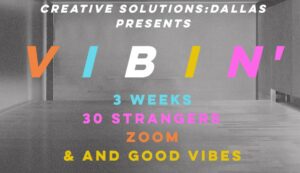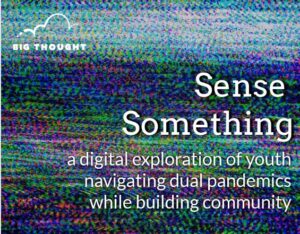After 27 Years, Creative Solutions Continues to Reach Youth Through the Arts
A three-hour session of air hockey.
That’s how Sasha Maya Ada Davis described a day at Creative Solutions’ three-week summer program. “They give you something, and you have to give it back to them,” said Davis, the Creative Lead for Creative Solutions at Big Thought.
An arts-as-workforce intervention program for adjudicated and marginalized youth, Creative Solutions combines trauma-informed methodology, workforce skills and creative expression to help them discover their greatness.
Year-round sessions at Dallas County Juvenile facilities are offered for youth ages who are assigned there, and the intensive summer program, which usually lasts seven weeks, is for youth referred by their probation officer.
In 2020, the summer program, which also launched in Tarrant County for the first time, went completely virtual. Not only did Davis want youth to be safe from COVID-19, but in the wake of George Floyd’s death and citywide protests, she didn’t want them to have to justify their presence on trains or buses.
 Transitioning to both a shorter duration and remote model meant that Creative Solutions had to get creative
Transitioning to both a shorter duration and remote model meant that Creative Solutions had to get creative
Transitioning to both a shorter duration and remote model meant that Creative Solutions had to get, well, creative, while still sticking to what’s made the program a success for more than two decades. “This program is 27 years old now — 27 years of creating devised work,” Davis said. “I come from a theater background, so devised really does mean for me all of the voices are included. We’re just there to help give them tools.”
This summer, the theme was rebuilding connections due to the trauma experienced from COVID-19, with each week centered on trust, flexibility and vulnerability. It was a focus that resonated with Davis and the program’s teaching artists personally — when we aren’t able to see friends and loved ones in person, how do we recreate those bonds?
Davis asked the program’s teaching artists to put together an arts kit that allowed as much freedom of expression as possible. “I didn’t want a structured certain end product because I didn’t know what the kids were bringing in,” she said.
And as each day’s session unfolded, an emphasis was placed on what the youth themselves wanted to talk about — creating that game of air hockey. For Davis, asking the youth what they want more valuable and easier than too much pre-planning. “It’s a lot more fun, and it’s a lot more genuine to them.”

The changes made this summer made space for creativity and collaboration
The changes made this summer, including combining the two traditional separate program tracks — visual and performing arts — into one, made space for creativity and collaboration.
In one activity, the movement teaching artist had youth create a hand sign that represented their name and who they are as a person. The visual teaching artist had them translate that into a web bubble with their name in the center and eight offshoots of things that describe them — it was then turned into art. Having the teaching artists working together also gave youth permission to play off each other too.
That collaboration was echoed throughout the entire staff. “In physical CS, there isn’t as much collaboration between the logistics team and the teaching artists,” Davis said. “This year, it was, ‘We’re all going in; we’re all going to figure this out.’ I’m just so thankful for the many teams giving their trust to something that we didn’t even know if it was possible or not.”
The virtual setting did mean a slightly different mindset for staff, who were given a look into the homes of youth. There conversations about how to react to what they might see or hear, and how best they would be able to check in to make sure everyone was OK if any situations arose.
Throughout the three weeks, the emphasis for teaching artists was to be themselves to encourage youth to build relationships with each other. “At a certain point with both cities, it was like we didn’t have to be there anymore,” Davis said. “That they could just connect with each other — which is difficult, it’s difficult to build that connection with strangers online that you’ve never met before — that was pretty beautiful.”
It was the mark of a successful program pulled off despite the summer’s challenging circumstances, one the Creative Solutions team can look to as they move into the fall. “It’s a nice: ‘All right, we know how to do this now,’” Davis said. “We fumbled, we’re going to fumble again, but we’ll be stronger next time.”
In the coming months, Creative Solutions will continue to juggle what Davis calls the program’s “many moving parts,” with the focus shifting to in-facility programming and short-term projects that can be accomplished there. That includes one idea to have youth create their own beats with help from a local organization.
But no matter what Creative Solutions does next, one thing will remain the same — the emphasis on making sure adjudicated youth feel heard, cared for and included in planning.
It’s all part of a larger goal to use the arts to help youth discover their own greatness and develop strategies for lasting positive change.
Check out the youths’ digital art creations from Summer 2020:
 Transitioning to both a shorter duration and remote model meant that Creative Solutions had to get creative
Transitioning to both a shorter duration and remote model meant that Creative Solutions had to get creative